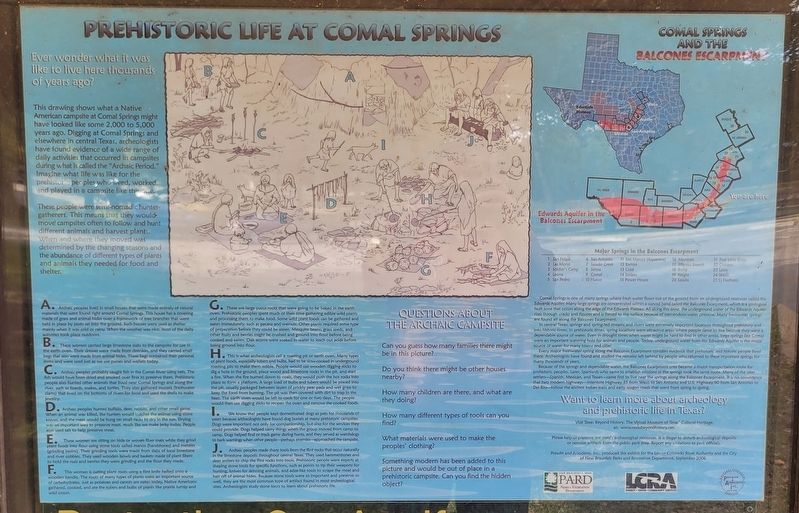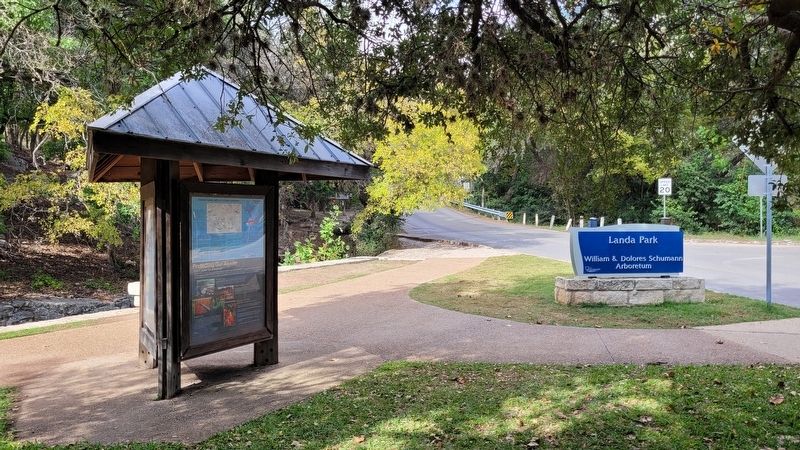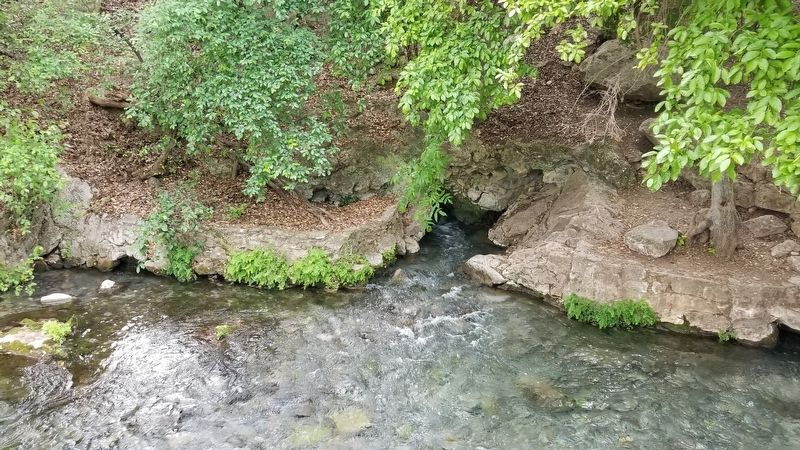New Braunfels in Comal County, Texas — The American South (West South Central)
Prehistoric Life at Comal Springs
This drawing shows what a Native American campsite at Comal Springs might have looked like some 2,000 to 5,000 years ago. Digging at Comal Springs and elsewhere in central Texas, archeologists have found evidence of a wide range of daily activities that occurred in campsites during what is called the "Archaic Period." Imagine what life was like for the prehistoric peoples who lived, worked, and played in a campsite like this one.
These people were semi-nomadic hunter-gatherers. This means that they would move campsites often to follow and hunt different animals and harvest plants. When and where they moved was determined by the changing seasons and the abundance of different types of plants and animals they needed for food and shelter.
A. Archaic peoples lived in small houses that were made entirely of natural materials that were found right around Comal Springs. This house has a covering made of grass and animal hides over a framework of tree branches that were held in place by posts set into the ground. Such houses were used as shelter mainly when it was cold or rainy. When the weather was nice, most of the daily activities took place outdoors.
B. These women carried large limestone slabs to the campsite for use in the earth oven. Their dresses were made from deerskin, and they carried small bags that also were made from animal hides. These bags contained their personal Items and were used just as we use purses and wallets today.
C. Archaic peoples probably caught fish in the Comal River using nets. The fish would have been dried and smoked over fires to preserve them. Prehistoric people also hunted other animals that lived near Comal Springs and along the river, such as lizards, snakes, and turtles. They also gathered mussels (freshwater clams) that lived on the bottoms of rivers for food and used the shells to make Jewelry.
D. Archaic peoples hunted buffalo, deer, rabbits, and other small game. When an animal was killed, the hunters would butcher the animal using stone knives, and the meat would be hung on small racks to dry in the sun. Drying was an important way to preserve meat, much like we make jerky today. People also used salt to help preserve meat.
E. These women are sitting on hide or woven fiber mats while they grind plant foods into flour using stone tools called manos (handstones) and metates (grinding basins). Their grinding tools were made from slabs of local limestone and river cobbles. They used wooden bowls and baskets made of plant fibers to hold the nuts and berries they were grinding and the flour they made.
F. This woman is cutting
plant roots using a flint knife hafted onto a wooden handle. The roots of many types of plants were an important source of carbohydrates. Just as potatoes and carrots are eaten today, Native Americans gathered, cooked, and ate the tubers and bulbs of plants like prairie turnip and wild onion.
G. These are large yucca roots that were going to be baked in the earth oven. Prehistoric peoples spent much of their time gathering edible wild plants and processing them to make food. Some wild plant foods can be gathered and eaten immediately, such as pecans and walnuts. Other plants required some type of preparation before they could be eaten. Mesquite beans, grass seeds, and other fruits and berries might be crushed and ground into flour before being cooked and eaten. Oak acorns were soaked in water to leach out acids before being ground into flour.
H. This is what archeologists call a roasting pit or earth oven. Many types of plant foods, especially tubers and bulbs, had to be slow-cooked in underground roasting pits to make them edible. People would use wooden digging sticks to dig a hole in the ground, place wood and limestone rocks in the pit, and start a fire. When the fire burned down to coals, they would push the hot rocks into place to form a platform. A large load of bulbs and tubers would be placed into the pit, usually packaged between layers of prickly
pear pads and wet grass to keep the food from burning. The pit was then covered with dirt to trap in the heat. The earth oven would be left to cook for one or two days. The people would then use digging sticks to reopen the oven and remove the cooked foods.
I. We know that people kept domesticated dogs as pets for thousands of years because archeologists have found dog burials at many prehistoric campsites. Dogs were important not only for companionship, but also for the services they could provide. Dogs helped carry things when the group moved from camp to camp. Dogs helped find or track game during hunts, and they served as watchdogs to bark warnings when other people - perhaps enemies - approached the campsite.
J. Archaic peoples made sharp tools from the flint rocks that occur naturally in the limestone deposits throughout central Texas. They used hammerstones and deer antlers to chip the flint rocks into tools. Prehistoric people were experts at shaping stone tools for specific functions, such as points to tip their weapons for hunting, knives for skinning animals, and adze-like tools to scrape the meat and hair off of animal hides. Because stone tools were so important and preserve so well, they are the most common type of artifact found in most archeological sites. Archeologists study stone tools to learn about prehistoric life.
Questions about the archaic campsite
Can you guess how many families there might be in this picture?
Do you think there might be other houses nearby?
How many children are there, and what are they doing?
How many different types of tools can you find?
What materials were used to make the peoples' clothing?
Something modern has been added to this picture and would be out of place in a prehistoric campsite. Can you find the hidden object?
and the
Balcones Escarpment
Major Springs in the Balcones Escarpment
1 San Felipe 2 Las Moras 3 Soldier's Camp 4 Leona 5 San Pedro 6 San Antonio 7 Salado Creek 8 Selma 9 Comal 10 Hueco 11 San Marcos (Aquarena) 12 Barton 13 Cold 14 Seiders 15 Power House 16 Mormon 17 Manske Branch 18 Berry 19 Knight 20 Salado 21 Fort Little River 22 Childers 23 Leon 24 Waco 25 El Flechazo
Comal Springs is one of many springs where fresh water flows out of the ground from an underground reservoir called the Edwards Aquifer. Many large springs are concentrated within a curved band called the Balcones Escarpment, which is a geological fault zone that occurs along the edge of the Edwards Plateau. All along this zone, the underground water of the Edwards Aquifer rises through cracks and fissures and is forced to the surface because of tremendous water pressure. Many freshwater springs are found all along the Balcones Escarpment.
In central Texas, springs and spring-fed streams and rivers were extremely important locations throughout prehistory and into historic times. In prehistoric times, spring locations were attractive areas where people came to live because they were a dependable source of water. Even in drought times when water might be hard to find in other areas, large springs like Comal were an important watering hole for animals and people. Today, underground water from the Edwards Aquifer is the major source of water for many towns and cities.
Every major freshwater spring along the Balcones Escarpment contains evidence that prehistoric and historic people lived there. Archeologists have found and studied the remains left behind by people who returned to these Important springs for many thousands of years.
Because of the springs and dependable water, the Balcones Escarpment area became a major transportation route for prehistoric peoples. Later, Spaniards who came to establish missions at the springs took the same route. Many of the later settlers - Spanish, Mexican, and Texan - came first to live near the springs along the Balcones Escarpment. It is no coincidence that two modern highways - Interstate Highway 35 from Waco to San Antonio and U.S. Highway 90 from San Antonio to Del Rio - follow the ancient Indian trails and early wagon roads that went from spring to spring.
Erected 2006 by Prewitt and Associates, Inc., Lower Colorado River Authority and the City of New Braunfels Parks and Recreation Department.
Topics. This historical marker is listed in these topic lists: Animals • Anthropology & Archaeology • Native Americans • Waterways & Vessels.
Location. 29° 42.76′ N, 98° 8.235′ W. Marker is in New Braunfels, Texas, in Comal County. Marker is at the intersection of Landa Park Drive and Gazebo Circle, on the left when traveling north on Landa Park Drive. The marker is located along the west side of Landa Park Drive. Touch for map. Marker is in this post office area: New Braunfels TX 78130, United States of America. Touch for directions.
Other nearby markers. At least 8 other markers are within walking distance of this marker. Comal Springs (within shouting distance of this marker); This Monument Marks the Location (within shouting distance of this marker); Site of Nuestra Seρora de Guadalupe Mission (about 300 feet away, measured in a direct line); Mayors' Monarch Pledge (about 300 feet away); New Braunfels Gemischter Chor Harmonie (about 400 feet away); It All Began Here (about 400 feet away); German Pioneers Monument (about 400 feet away); Founder's Oak (about 600 feet away). Touch for a list and map of all markers in New Braunfels.
Also see . . .
1. Comal Springs. Texas State Historical Association (Submitted on December 2, 2022, by James Hulse of Medina, Texas.)
2. Balcones Escarpment. Texas State Historical Association (Submitted on December 2, 2022, by James Hulse of Medina, Texas.)
Credits. This page was last revised on December 2, 2022. It was originally submitted on December 2, 2022, by James Hulse of Medina, Texas. This page has been viewed 144 times since then and 27 times this year. Photos: 1, 2, 3. submitted on December 2, 2022, by James Hulse of Medina, Texas.


